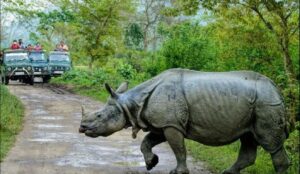
Kaziranga National Park, located in the northeastern state of Assam in India, is one of the most celebrated wildlife sanctuaries in the world. Covering an area of approximately 430 square kilometers, it is renowned for its rich biodiversity, unique ecosystem, and as a sanctuary for the endangered Indian one-horned rhinoceros.
History and Establishment of Kaziranga National Park
Kaziranga was declared a reserved forest in 1908 following the efforts of Mary Curzon, the wife of the Viceroy of India, Lord Curzon. She was inspired to protect the area after failing to see a single rhinoceros during her visit. Over the years, the park gained more protection, becoming a game sanctuary in 1916, a wildlife sanctuary in 1950, and finally achieving national park status in 1974. In 1985, Kaziranga was designated a UNESCO World Heritage Site due to its exceptional natural environment.
List of Flora and Fauna Species Found in Kaziranga National Park
Flora of Kaziranga Tiger Reserve
Kaziranga’s landscape is characterized by dense tropical moist broadleaf forests, tall elephant grass, marshland, and numerous small water bodies. The park’s vegetation supports a diverse array of life forms, creating a rich tapestry of habitats that are critical for the survival of many species.
Fauna of Kaziranga Tiger Reserve
Kaziranga is most famous for its population of the Indian one-horned rhinoceros, which accounts for about two-thirds of the world’s population of this species. As of the latest census, the park is home to more than 2,400 rhinos. The park also hosts significant populations of other megafauna, including:
- Elephants: Large herds of Asian elephants roam the park, often seen bathing in the park’s numerous water bodies.
- Tigers: Kaziranga is one of the highest-density tiger habitats in the world. The park was declared a Tiger Reserve in 2006.
- Wild Water Buffaloes: Home to a large population, Kaziranga is considered a stronghold for this species.
- Swamp Deer: Also known as Barasingha, they are commonly seen grazing in the grasslands.
In addition to these, Kaziranga supports over 480 species of birds, making it a birdwatcher’s paradise. Notable avian species include the Great Indian Hornbill, Bengal Florican, and various migratory birds.
Conservation Efforts for the Preservation of the Forest Species
Kaziranga’s success as a conservation area is attributed to the relentless efforts of the government, NGOs, and local communities. Anti-poaching measures are stringent, with armed forest guards patrolling the park. The use of technology, such as drones and electronic surveillance, has bolstered these efforts.
The park also engages in habitat management practices, such as controlled burning of grasslands to promote new growth and maintaining the wetlands to ensure the availability of water. These efforts have been crucial in maintaining the delicate balance of the ecosystem.

Rhino of Kaziranga National Park
Tourism Activity in UNESCO Declared World Heritage Kaziranga National Park
Kaziranga is a popular tourist destination, attracting visitors from around the globe. The best time to visit is from November to April when the weather is pleasant, and wildlife sightings are frequent. The park offers several activities for tourists:
- Jeep Safaris: The most popular way to explore the park, providing a chance to see the diverse wildlife up close.
- Elephant Safaris: These provide a unique vantage point and are particularly favored for rhino spotting.
- Bird Watching: With its rich avian diversity, guided bird-watching tours are a must for bird enthusiasts.
Challenges Faced in Kaziranga National Park
Despite its successes, Kaziranga faces several challenges. Human-wildlife conflict is a significant issue, with animals sometimes straying into nearby villages. Flooding during the monsoon season poses a threat to both animals and the park’s infrastructure. Additionally, poaching remains a constant threat, particularly for rhinos, which are targeted for their horns.
Conclusion of the Story of Kaziranga National Park
Kaziranga National Park stands as a testament to India’s conservation success. Its lush landscapes, diverse wildlife, and rigorous protection measures make it a crucial haven for many endangered species. However, continued efforts are necessary to mitigate ongoing challenges and ensure that this natural paradise remains intact for future generations. Through collective conservation efforts, Kaziranga will continue to be a beacon of biodiversity and natural beauty.





